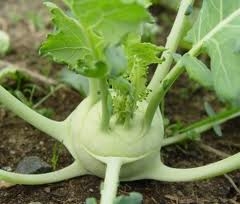
Cabbage, collards and kale are grown for their leaves, and broccoli and cauliflower for their immature flower heads, but kohlrabi is grown for its stem. It forms a round, crisp globe just above ground, with leaves growing above that. Although the plant is a bit odd-looking, the stem is delicious and can be eaten raw or cooked. In flavor, it is like a mild, sweet broccoli stem or turnip.
Last summer, several Napa County Master Gardeners tried growing kohlrabi in our gardens. Most of us had never grown it before. We chose three varieties: the purple ‘Azure Star’ and two green varieties,‘Superschmelz’ and ‘Kossak F1’.
Harvest typically begins when the stems have reached a diameter of two to four inches. The ‘Superschmelz’ was advertised as being tender up to eight inches in diameter.
Like its better-known siblings, kohlrabi is a cool-season plant. We grew it as a fall crop, starting seed in late summer so the crop would mature in late fall.
Kohlrabi can be seeded directly in the ground or started indoors for transplanting later. Planting seeds directly in the garden in midsummer presents some challenges. It’s hard to keep the soil evenly moist, a must for good germination. Also, insect pests seem to be at their highest numbers in warm weather, and little seedlings are vulnerable. Most of the gardeners decided to start their seeds indoors in containers.
One dilemma for plants started indoors is getting enough sunlight. A sunny window is often not enough. As soon as my seeds sprouted, which took less than a week, I moved the containers outside to a sunny deck with a high patio umbrella. I monitored them daily for moisture and put them in shade on hot afternoons. This strategy turned out to be successful for me, although another Master Gardener lost all the plants on his deck to a critter. We suspect the culprit was a raccoon.
Commercially grown plants are sold at about six weeks old. I started my seedlings in recycled six-packs and transplanted them at four weeks, as they were getting too big. I amended the garden soil with compost and organic fertilizer and made sure the irrigation line was working. Kohlrabi needs a minimum spacing of 12 inches.
I planted 12 of each variety. Since they had been living outside on my deck, the seedlings did not need hardening off. If they had been started in a greenhouse like commercial plants, I would have kept them outside for a week before planting. As you do with tomato plants, you can bury the seedling’s stem deeply to encourage rooting.
As soon as plants are in the ground, pests become an issue. Small plants in my garden are magnets for birds such as towhees and quail, so I used bird netting over the bed.
Kohlrabi attracts the same insect pests that afflict cabbage and broccoli, including several kinds of caterpillars. A floating row cover of lightweight spun fabric allows light and rain to reach plants but excludes insects. Check the underside of leaves for egg cases, and inspect stems for caterpillars. Remove by hand. With attentive monitoring and the help of natural predators, you can keep damage to a minimum.
Aphids can also plague kohlrabi, but a row cover will help. Monitoring for aphids and washing them off the plant with a spray of water keeps the population under control. Since aphids attack the soft parts of the plant, primarily the leaves, you can still get a nice crop in spite of them.
I felt fortunate in my results, eventually harvesting 31 of the original 36 transplants. My first kohlrabi was harvested in October, 74 days after planting the seeds and 54 days after transplanting. These results were consistent with seed-packet information.
The ‘Azure Star’ variety produced kohlrabi two to three inches in diameter, while both green varieties got larger the longer they were in the ground. I noticed no difference in flavor among varieties. I harvested one or two kohlrabi a week through the winter. The last one, large but still tender, was harvested in March.
I found amazing salad and side-dish recipes online, and because the harvest was so well paced, I never got tired of it. Kohlrabi is definitely going to be in my cool-season garden this year.
Workshop: Napa County Master Gardeners will host a workshop on “Cool Season Veggies” on Sunday, August 18, from 2 p.m. to 4 p.m. at the Yountville Community Center, 6516 Washington Street, Yountville. Grow your own vegetables even when days are short and nights are cold. The key is starting while weather and soil are still warm. Learn which vegetables will thrive in cooler temperatures, how to protect them from heat when they are getting started, and how to time plantings for months of harvest. Register through Town of Yountville, Parks and Recreation: Mail in or Walk in registration (cash or check only).
Garden Tour: Napa County Master Gardeners will host a self-guided garden tour, “Down the Garden Path,” on Sunday, September 22, from 10 a.m. to 4 p.m. Visit seven unique gardens in and around downtown Napa, all maintained by Master Gardeners. Tickets: $25 advance/$30 day of event. Purchase tickets online at http://ucanr.edu/ucmgnapa. For more information about the tour and tickets, visit our web site (address below) or call 707-253-4147. Find us on Facebook under UC Master Gardeners of Napa County.
Master Gardeners are volunteers who help the University of California reach the gardening public with home gardening information. Napa County Master Gardeners ( http://ucanr.org/ucmgnapa/) are available to answer gardening questions in person or by phone, Monday, Wednesday and Friday, 9 a.m. to Noon, at the U. C. Cooperative Extension office, 1710 Soscol Avenue, Suite 4, Napa, 707-253-4143, or from outside City of Napa toll-free at 877-279-3065. Or e-mail your garden questions by following the guidelines on our web site. Click on Napa, then on Have Garden Questions?